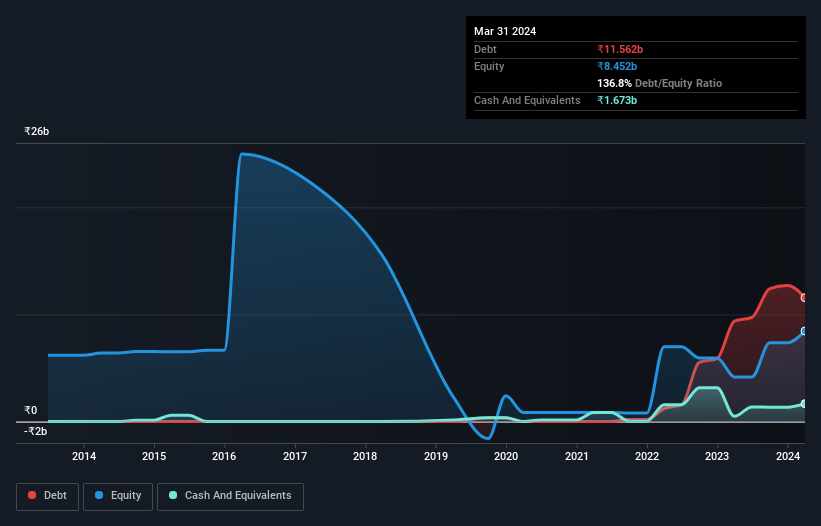- India
- /
- General Merchandise and Department Stores
- /
- NSEI:RTNINDIA
These 4 Measures Indicate That RattanIndia Enterprises (NSE:RTNINDIA) Is Using Debt Reasonably Well

Some say volatility, rather than debt, is the best way to think about risk as an investor, but Warren Buffett famously said that 'Volatility is far from synonymous with risk.' When we think about how risky a company is, we always like to look at its use of debt, since debt overload can lead to ruin. We can see that RattanIndia Enterprises Limited (NSE:RTNINDIA) does use debt in its business. But is this debt a concern to shareholders?
What Risk Does Debt Bring?
Generally speaking, debt only becomes a real problem when a company can't easily pay it off, either by raising capital or with its own cash flow. Part and parcel of capitalism is the process of 'creative destruction' where failed businesses are mercilessly liquidated by their bankers. However, a more common (but still painful) scenario is that it has to raise new equity capital at a low price, thus permanently diluting shareholders. Of course, debt can be an important tool in businesses, particularly capital heavy businesses. When we examine debt levels, we first consider both cash and debt levels, together.
View our latest analysis for RattanIndia Enterprises
What Is RattanIndia Enterprises's Debt?
As you can see below, at the end of March 2024, RattanIndia Enterprises had ₹11.6b of debt, up from ₹9.37b a year ago. Click the image for more detail. On the flip side, it has ₹1.67b in cash leading to net debt of about ₹9.89b.

A Look At RattanIndia Enterprises' Liabilities
We can see from the most recent balance sheet that RattanIndia Enterprises had liabilities of ₹18.0b falling due within a year, and liabilities of ₹504.0m due beyond that. Offsetting this, it had ₹1.67b in cash and ₹450.5m in receivables that were due within 12 months. So it has liabilities totalling ₹16.3b more than its cash and near-term receivables, combined.
Since publicly traded RattanIndia Enterprises shares are worth a total of ₹101.9b, it seems unlikely that this level of liabilities would be a major threat. However, we do think it is worth keeping an eye on its balance sheet strength, as it may change over time.
We use two main ratios to inform us about debt levels relative to earnings. The first is net debt divided by earnings before interest, tax, depreciation, and amortization (EBITDA), while the second is how many times its earnings before interest and tax (EBIT) covers its interest expense (or its interest cover, for short). Thus we consider debt relative to earnings both with and without depreciation and amortization expenses.
RattanIndia Enterprises's net debt is sitting at a very reasonable 1.6 times its EBITDA, while its EBIT covered its interest expense just 5.4 times last year. While these numbers do not alarm us, it's worth noting that the cost of the company's debt is having a real impact. Notably, RattanIndia Enterprises's EBIT launched higher than Elon Musk, gaining a whopping 1,324% on last year. There's no doubt that we learn most about debt from the balance sheet. But you can't view debt in total isolation; since RattanIndia Enterprises will need earnings to service that debt. So if you're keen to discover more about its earnings, it might be worth checking out this graph of its long term earnings trend.
Finally, while the tax-man may adore accounting profits, lenders only accept cold hard cash. So we always check how much of that EBIT is translated into free cash flow. During the last two years, RattanIndia Enterprises burned a lot of cash. While investors are no doubt expecting a reversal of that situation in due course, it clearly does mean its use of debt is more risky.
Our View
Based on what we've seen RattanIndia Enterprises is not finding it easy, given its conversion of EBIT to free cash flow, but the other factors we considered give us cause to be optimistic. In particular, we are dazzled with its EBIT growth rate. Looking at all this data makes us feel a little cautious about RattanIndia Enterprises's debt levels. While debt does have its upside in higher potential returns, we think shareholders should definitely consider how debt levels might make the stock more risky. The balance sheet is clearly the area to focus on when you are analysing debt. But ultimately, every company can contain risks that exist outside of the balance sheet. To that end, you should be aware of the 2 warning signs we've spotted with RattanIndia Enterprises .
At the end of the day, it's often better to focus on companies that are free from net debt. You can access our special list of such companies (all with a track record of profit growth). It's free.
New: AI Stock Screener & Alerts
Our new AI Stock Screener scans the market every day to uncover opportunities.
• Dividend Powerhouses (3%+ Yield)
• Undervalued Small Caps with Insider Buying
• High growth Tech and AI Companies
Or build your own from over 50 metrics.
Have feedback on this article? Concerned about the content? Get in touch with us directly. Alternatively, email editorial-team (at) simplywallst.com.
This article by Simply Wall St is general in nature. We provide commentary based on historical data and analyst forecasts only using an unbiased methodology and our articles are not intended to be financial advice. It does not constitute a recommendation to buy or sell any stock, and does not take account of your objectives, or your financial situation. We aim to bring you long-term focused analysis driven by fundamental data. Note that our analysis may not factor in the latest price-sensitive company announcements or qualitative material. Simply Wall St has no position in any stocks mentioned.
About NSEI:RTNINDIA
RattanIndia Enterprises
Engages in the manpower, human resource supply and consultancy, payroll management, technology, and other related services in India.
Slightly overvalued with questionable track record.
Market Insights
Community Narratives




